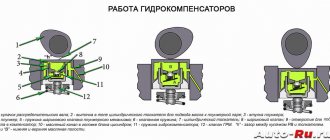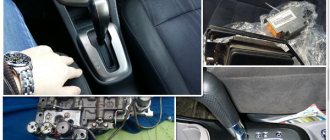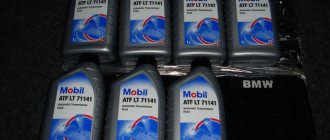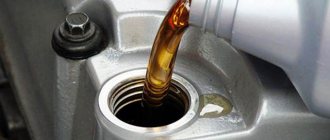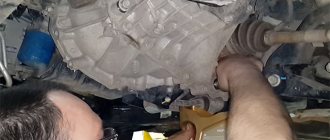Carbon protection on rings and valves
In order not to get rid of carbon deposits and sticking of engine rings in emergency mode, it is recommended to use the above fuel additives regularly.
There are no side effects from them, but the owner will be confident that there are no hydrocarbon deposits and oil that has penetrated there and are not completely burned in the fuel chamber. At the same time, soft decoking of the engine does not have exact time limits; the mixture will have to be added to the oil and fuel constantly. This is expensive, but it allows you to simultaneously improve the condition of the compression rings, catalysts, sensors and injection system.
Hard carbon removal technologies are less expensive, but bring a one-time effect without preventing further deposition of products of incomplete combustion on the same surfaces in the future.
Properties of the additive and rules for its use
Chevrolet Cruze egemo Logbook Changing the oil in an automatic transmission
As was found out above, additives in an automatic transmission guarantee that the mechanism will serve for a certain period of time without breakdowns associated with the use of low-quality transmission fluid. Modern additives in automatic machines perform several important functions at once. To be more precise, their list is as follows:
Restoring the lubricating properties of oil from the box, which extends its service life; Increasing the speed of warming up the automatic transmission mechanism, which is quite important in cold seasons; Cleaning the internal components of the machine from various types of dirt (corrosive manifestations, carbon deposits, oil dust, waste products, etc.); Favorable and restorative effect on the rubber elements of the mechanism; Partial increase in the oil level in the box, which will be useful if there is a slight deficiency.
When deciding to “feed” the box with additives, do not forget about the rules for their use. Often the following measures are sufficient:
- The volume of the additive to be poured is calculated based on how much transmission fluid is poured into the automatic transmission. With a box volume of 6-9 liters, one standard cylinder of the product is enough, with a unit capacity of 9-12 liters, two such cylinders will be required, but with a larger volume, it is worth using three containers with an additive;
- It is advisable to use the additive every 10-20,000 kilometers, but no more than 3 times for one transmission fluid;
- When using the product for the first time, you need to fill it in the required amount and drive it for 2-3 days. After this, all transmission fluid is drained and new one is filled in with the additive being re-added. This measure is necessary for high-quality and complete cleaning of the insides of the automatic transmission from contaminants.
Tips for use
There are a number of additives that auto mechanics do not recommend using.
First of all, these are compositions aimed at extending the service life of gear oil. It needs to be changed at the recommended frequency.
You can often hear warnings regarding the use of sealing compounds. The fact is that they briefly create a protective layer not only in the place where the leak appeared, but over the entire area of the parts, which worsens the operation of the manual transmission. Therefore, the main task of such a mixture is to allow the car to be delivered to a service center without using a tow truck. It is not intended for regular use.
There are several basic rules:
- additives should be added only after replacing the oil with a new one;
- before pouring the composition into the manual transmission, the container should be shaken thoroughly;
- it is necessary to follow the proportions recommended by the manufacturer.
Lubegard I DO NOT RECOMMEND OTHER ADDITIVES IN THE AUTOMATIC TRANSMISSION Camry
Nissan X-Trail RedBull Logbook Changing the oil and filter in the automatic transmission
Andrey
please tell me why the OD OFF lamp started flashing on a Toyota Camry 3S-SW-35 4 wd after repairing the automatic transmission. With all respect, Andrew
.Malfunction. So it was repaired. Diagnose, read the error..
Vitaly
Thank you very much for your response to the letter dated December 09, 2010 about the Camry and A540E. Please tell me what is included in REVERSE BRAKE. THANKS IN ADVANCE! HUGE RESPECT TO YOU FOR EVERYTHING!
.1. Steel disks;2. Discs with linings;3. Spring ring;4. Stopper;5. Return springs;6. Reverse piston;7. Piston seals (2 rubber rings)..
Sergey
Tayeta Camry 1992 Automatic transmission 540e. When you turn on D or 2, it is difficult to move away and picks up speed slowly (slips), having reached a certain speed, it switches to all the next gears, but if you press the gas pedal a little sharper, then in any of the gears it also slips
.The automatic transmission is on, there is a clear loss of pressure on the seals. We connect the pressure gauge and measure the linear pressure on the hot transmission. If the pressure is below the table (it will be 100% lower), overhaul the automatic transmission..
alex
.Honda Civic 2001 SLXA. Mileage 200,000. Does it make sense to fill in the Lubegard additive? Tell me what its principle of operation is and what improves when using it. The automatic transmission works well. Does it make sense to install an additional radiator on the automatic transmission on this car? Will it make it worse in winter? Thanks in advance.
.1. “Does it make sense to add the Lubegard additive? Tell me what its principle of operation is and what improves when using it.” — everything is written here https://lubegard.ru/katalog/automatic_transmission/universal_automatic_transmission_fluid_protectant_platinum.html2. “The automatic transmission works well” - well, don’t interfere with its work! 3. “Does it make sense to install an additional radiator on an automatic transmission on this car?” - a racer? Frequent driving in city traffic jams? Then has.4. “Won’t it make it worse in winter?” — in parallel with the main one with the possibility of switching off or through a bypass valve thermostat..
Yuri
Good afternoon Please tell me if there are analogues of the universal modifying stabilizer for transmission fluid LUBEGARD PLATINUM. I can’t find it in Ivanovo. There are Hi-Gear, Liqui Moly and Russian stuff. Please advise.
.1. “Hi-Gear” - will ruin the automatic transmission; 2. “Liqui Moly” - after this, the automatic transmission has not been repaired, so I can’t say anything about this stuff, I think it also “liquefies” the seals; 3. According to Lubegard, in Moscow, “The TRANSPARTS company is the official dealer of LUBEGARD products in the North-Western and Central Federal Districts.”
4. I DO NOT RECOMMEND OTHER ADDITIVES TO BE POURED INTO THE AUTOMATIC TRANSMISSION, DESTROY THE AUTOMATIC TRANSMISSION...
Features of application
The practical use of additives does not pose any particular difficulties. Motorists need to carefully read the instructions and strictly follow the requirements given there.
The contents of the package with additives are poured into the heated gearbox. The car engine must be turned on and idling. The substance must be poured very slowly. Then you should drive using all gear shift modes.
When flushing additives are used, the engine is turned off. After this, change the filter and transmission fluid. Engine and transmission cleaner additives can be useful when purchasing used vehicles with unknown service history. Also suitable for worn-out cars in which the automatic transmission is combined with various types of gasoline or diesel engines.
It may take some time or a certain mileage to notice the effect. This depends on the design features of a particular automatic transmission. You can navigate 1500 km. This standard is an average.
The maximum permissible volume of additives used must be observed. Exceeding the specified amount does not accelerate the manifestation of the positive effect. In case of an overdose, negative consequences are quite possible.
The specially used ATF lubricant is designated Automatic Transmission Fluid. It is designed to protect and trouble-free operation of the box, eliminates excess heat and minimizes friction on the surface of parts.
Excessively aggressive driving leads to sudden overheating of the automatic transmission and loss of its functionality. This causes a loss of the basic properties of the oil used. This situation can lead to rapid wear of the mechanisms and breakdown of the automatic transmission.
Technologies in the automotive sector are regularly progressing and therefore special additives have been developed for the full operation of automatic transmissions. This is a great alternative to prematurely servicing the box.
Timely use of the additive composition will restore the factory properties of the automatic transmission and extend its service life. If we consider that the cost of repairs is much more expensive than new lubricant, then the car owner also receives additional savings in money and personal time.
Automatic transmissions
conditioning additives
Every motorist wants to know which automatic transmission additives are the best and what is best to put in automatic gearboxes. But objectively, the best additive for automatic transmissions cannot exist alone. These are at least several solutions that interact perfectly with the machine. Therefore, the choice of additive to be poured into an automatic transmission should be approached carefully in order to buy and fill in the additive that is not just well advertised on TV or on the Internet. Often, buyers are fooled by marketing decisions, which is why they overpay for a brand without receiving real benefits
If you are really interested in the best additive for automatic transmissions, then you should pay attention to several current leaders in the segment
RVS Master
RVS for automatic transmissions are made on the basis of magnesium silicate salts and auxiliary components. They allow you to create a protective and wear-resistant film on the surface of parts. Using such means, you can restore the geometry of automatic transmission components, stabilize the operation of all components and extend their service life. The additive helps eliminate noise and vibration, reduces the intervals between gear shifts in automatic transmissions. Studies have shown that RVS effectively resists the phenomenon of slipping if it is caused by malfunctions in the automatic transmission.
Liqui Moly
It will not surprise anyone if the best additive turns out to be the result of the work of Liqui Moly. Their automatic transmission solutions can protect and restore friction surfaces. Special compositions restore the elasticity of the seals and prevent lubricant leaks in the automatic transmission. By using additives from this company, designed specifically for automatic transmissions, you will extend the life of the automatic transmission and be able to preserve the original properties of the transmission oil.
Suprotec
Their automatic transmission additives are based on creating a metallized layer. With its help, the geometry of parts is restored and reliable protection against premature wear is created. When added, the additive has a positive effect on the characteristics and physical and chemical composition of the oil. Correct use of the product will help reduce noise levels and improve the smoothness of gear shifting in automatic mode. Tests have proven that the Suprotec additive for automatic transmissions extends the service life of the unit.
Wynns
The composition is created from organic components and neutral metallic substances. This allows you to fill the additive into any automatic transmission, regardless of the gear oil used in it. The action of the additive is aimed at removing accumulated deposits and protecting against oxidative processes in automatic transmission oil. The product can fill minor cracks on the surfaces of automatic transmission parts. This is a universal solution that is used on different types of transmissions.
Mos Two Ultra
Domestic additives that should not be ignored. Currently, they enjoy impressive popularity among Russian car owners. Additives are gradually becoming in demand abroad. This is due to the additive’s ability to create a protective coating, prevent premature wear of the automatic transmission and reduce friction between surfaces. The product has been tested and proven effective in combating extraneous noise and vibrations. Also, if used correctly, the additive will help increase the service life of the transmission.
Automatic transmission additives from Hado
Hado Chemical Group is an international group of companies and, according to their statements, is one of the most advanced companies in the field of nanotechnology. The Hado company began its activities in Kharkov in the early 90s.
According to the manufacturer, the Hado additive has an almost magical effect: it protects rubbing parts and even restores them, eliminates irregularities and defects, reduces noise and vibration, improves oil characteristics, helps the automatic transmission carry loads, smoothes the operation of the machine and increases comfort.
Reviews about Hado products are mostly positive - their products really have a good effect on the operation of the automatic transmission. Experienced car enthusiasts say that the advantages of their products include the fact that Hado oils are safe for humans and “do not cause skin cancer.”
Why are additives needed in automatic transmissions and how often are they used?
The operating temperature of individual components and assemblies of an automatic transmission ranges between -50°C and +400°C. The oil used is sensitive to overheating and cooling, since the longer the liquid is used under such conditions, the less it corresponds to the declared properties. Operation of the box at a temperature that does not correspond to the required value is the cause of mechanism malfunctions. Plus, the parts are affected by frictional forces, leading to wear of the box and, as a result, even greater contamination of the lubricant. To compensate for the lost properties of ATF fluid and compensate for mechanical wear of the gearbox, additives are used that are poured into the automatic transmission oil.
Benefits stated by the manufacturer
All compounds with protective and restorative properties were created to improve the technical characteristics of automatic transmissions and to restore them. They create two types of coatings:
- By coating friction discs, additives strengthen their surface and increase the coefficient of friction. This ensures reduced slippage of these disks.
- In the second case, the composition ensures creation on metal parts, which provides more reliable protection against wear and even partial restoration of already damaged surfaces.
Other advantages of additives declared by the manufacturer include:
- Automatic transmission oil additives are aimed at increasing the performance of the hydraulic pump and the pressure indicators of the entire automatic transmission hydraulic system. Everyone who added additives for preventive purposes noted that it felt like a completely new box.
- The ability of these compounds to flush oil channels is also of no small importance. This feature also improves the performance of all nodes.
- They are highly compatible with other lubricants and can be used in almost any car.
- The materials are quite affordable both in price and in their availability in specialized stores.
Why is this necessary?
One of the functions of piston rings, along with sealing the combustion chamber and preventing piston overheating, is to regulate the thickness of the engine oil film on the cylinder. The oil scraper rings included in the piston set are responsible for this. The compression rings located above are, in turn, responsible for the tightness of the fuel combustion chamber.
During operation, deposits form on the oil scraper rings as a result of friction, exposure to hot exhaust gases and combustion products of fuel and oil. They are especially typical for diesel cars, the fuel for which contains a high percentage of sulfur.
As carbon deposits increase, the rings become coked, that is, they lose their mobility and cease to fully perform their function of removing excess oil from the cylinder walls. As a result, excess oil remains on the cylinder walls and begins to burn, which leads to even more carbon deposits.
Decoking - cleaning piston group parts from carbon deposits
Coking itself is quite natural, since it is an integral part of the engine wear process. Improper use of the vehicle can significantly accelerate the onset of this phenomenon. The following actions lead to coking of the piston rings:
- violation of engine oil change periods;
- use of low quality oil;
- adding low-quality additives;
- motor overheating;
- increased thermal operating conditions of the engine due to problems with the cooling system;
- lack of vehicle operation in winter, or short trips at sub-zero temperatures;
- driving with a cold engine in the winter;
- long idle time of the car (several months).
Coking can also occur for natural reasons. Even taking all measures to avoid this phenomenon will not help if the car's mileage has exceeded 100 thousand km.
Most often, piston rings are made of cast iron or alloy steel
Engine coking is manifested by the following symptoms:
- reduced compression appears in the engine cylinders;
- the car noticeably loses power;
- oil consumption increases sharply;
- Blue or black smoke comes out of the exhaust pipe.
If these signs are observed, it is advisable to decarbonize the engine. If this is not done, then during further operation the wear of the parts of the cylinder-piston group will significantly accelerate. The formation of microcracks due to increased friction as a result of wear is a direct path to expensive engine overhaul.
Popular brands of additives
There are many manufacturers on the market, however, there are not many famous brands.
Liqui Moly is a product of a German manufacturer specializing in the production of automotive chemicals. The products have proven themselves to be in demand and trusted. Each Liqui Moly automatic transmission additive is certified and meets the stated characteristics. Products are tested in several independent European laboratories, which guarantees the veracity of the information provided. The tests carried out confirm that the use of the additive leads to an increase in the service life of the box, a reduction in noise, and an increase in fuel efficiency. As a rule, the containers produced, a bottle, one container is enough for 5 liters of transmission fluid
Hi-Gear, American manufacturer of chemicals for vehicles. The company is a leader in the production of additives in more than 25 countries of the world. The brand has its own scientific center that tests and studies the effects of products on automatic transmissions, so the company’s additives are high-tech.
Supplements have become widespread:
- HG7011 (ER): additive base, metal ER. The material reduces vibration and noise of the box, which increases the service life of the unit. The additive is compatible with any transmission oils and automatic transmissions;
- HG7018 (SMT2): additive using high quality materials, which includes SMT2 conditioner. The additive reduces the level of friction and noise, increasing the service life of the box. The product is compatible with any oils and automatic transmissions;
- HG7012 (SMT2): Contains a conditioner that eliminates vibration in the operation of the box.
XADO, products that have achieved popularity thanks to the use of new technologies. The XADO Chemical Group company was established in 1991 in the city of Kharkov. The company's products for automatic transmissions are represented in different countries with the additive Revitalizant EX 120. The additive in XADO automatic transmissions protects the transmission, reduces noise levels, and restores worn parts. After processing, the surface of the product receives a ceramic coating that restores the original layer. The additive is compatible with any oil and automatic transmission.
Benefits of using XADO:
- Elimination of scratches and cavities on the surface of the box product;
- Reduced box noise level;
- Optimizes the operation of box synchronizers;
- Fuel efficiency of the box;
- Elimination of transmission fluid leaks in the box;
When using additives, remember that the desired result will only be obtained if the product is used correctly. Violation of the operating rules will negate the work, even if the additive is impeccable. In addition, the additive is a preventive measure and does not replace box maintenance.
Superdrive additive
According to the manufacturer, the Superdrive additive is compatible with all types of motor oils and is the most effective in the world in terms of impact. What is noteworthy is that the effect of it occurs after 1000 kilometers. And this is a fairly large distance by which you will travel from the seller of this potion. Superdrive protects the gearbox from friction, optimizes technological clearances, reduces fuel consumption and even increases engine power, while increasing its environmental friendliness, and increases oil life by 2 or even 3 times.
What is included in popular automatic transmission additives?
As a rule, exact information about the composition of additives is not disclosed by the manufacturers themselves. However, analysis of various products reveals that the compositions are often based on an additive of high molecular weight polymers. These polymers allow the formation of a protective film to eliminate dry friction.
Also, to restore surfaces, so-called revitalizants (tiny particles of metals and ceramics) are added to the additive composition. These elements settle on surfaces, “smoothing out” defects and reducing gaps. A special metal-ceramic layer is also formed that can withstand heavy loads and protect surfaces from wear.
If we consider various products for automatic transmissions, then on the market for automatic transmissions we can separately highlight Liqui Moly and XADO additives, and car enthusiasts actively use RVS Master.
In the case of XADO additives, XADO revitalizants, which contain so-called “liquid ceramics,” are in demand for automatic boxes. Silicon compounds quickly settle on surfaces due to the presence of boron nitrate. Next, the composition fills the cracks, a protective layer is formed on the parts, which increases the service life of the automatic transmission.
According to the manufacturer, this additive can be poured into any transmission oil (manual transmission, automatic transmission), and the oil does not change its physical and chemical properties.
Liqui Moly additives are based on molybdenum, which is a friction modifier. Molybdenum disulfide allows you to reduce loads and temperatures at the interfaces of parts, and reduce operating noise.
This component is also capable of restoring the elasticity of plastic and rubber parts, which allows eliminating small leaks of ATF fluid.
The RVS Master additive is similar in principle of action and composition to Hado, however, it is noteworthy that this solution forms a coating whose thickness can be up to half a millimeter.
This allows you to not only fill microcracks, but also reduce gaps. The manufacturer also indicates that this additive has improved properties for cleaning the unit from difficult-to-remove deposits.
Rating of the best models
Below is a list of manufacturers whose formulations receive the maximum number of positive reviews from owners of cars with manual transmissions.
Xado
The manufacturer specializes primarily in revitalizants that restore worn manual transmission parts. It is recommended to use them after noise appears. They create a metal-ceramic protective layer on the surfaces, extending the service life of the mechanism.
MosTwo Ultra
The additive is suitable for any type of oil. Its main task is to create a film with a friction coefficient of less than 0.1. This reduces noise and makes transmission shifting easier. The additive can be used on new cars.
Getriebeoil Additive
Getriebeoil Additiv from Liqui Moly works using molybdenum disulfide. This is a universal composition that can be used both for prevention and for eliminating existing noise.
EX 120
EX 120 is one of the most popular revitalizants from Xado. The effect of its use becomes visible after approximately 1.5 thousand kilometers. The additive can improve the performance of even a heavily worn manual transmission. It is highly economical: only 8 ml of liquid is required for 2 liters of oil.
RVS Master
Compounds from RVS Master can compensate for flaws and scratches up to 0.5 mm deep. They help preserve the properties of transmission lubricant, especially at low temperatures.
Nanoprotec manual transmission 100
A distinctive feature of this additive is its 2-stage processing. At the first step, the solution must be poured into the old oil, after which it is used for another 3000 km. After this, the lubricant is replaced. A portion of Nanoprotec manual transmission 100 is immediately added to the new one.
Nanoprotec Max
The composition is in many ways similar to the previous one, it is also added in 2 stages. Focused on older cars.
Revitalizant
Revitalizant is another product from Xado. It is supposed to be added in 3 stages: the first time - immediately after changing the oil, the second and third - after 150 hours of engine operation.
Ways to reduce noise in gearboxes
Extraneous sounds always irritate the driver and cause concern. If something is noisy, then there is an obvious problem somewhere that definitely needs to be solved. Do not forget that if the gearbox is working properly, no unnecessary sounds should occur. If you notice that noise appears while driving or shifting gears, you should not delay and seek help. Diagnostics will make it clear what is wrong with the gearbox and what measures are suitable to eliminate the problem. Practice shows that box noise occurs due to several main reasons:
- the gap between transmission parts increases;
- gearbox teeth wear out;
- The viscosity of the transmission oil is impaired.
And here a natural question arises about how to get rid of noise. There are several solutions to solve this problem.
- Ignore extraneous noise. Despite the absurdity of this decision, many car owners choose it. This doesn't end well. The sounds gradually become louder and the box stops functioning normally. This all ends with expensive repairs, and sometimes a complete replacement of the gearbox.
- Disassemble the box, find the problem and fix it. A good way that will require your time and money. Dismantling some checkpoints takes a lot of effort and requires significant investment. Repairs are not always worth it, since a basic problem is discovered that can be fixed without dismantling.
- Use additives. They are intended for partial repair of small faults. Experts advise using them not because of the appearance of extraneous noise, but for prevention, in order to prevent the appearance of these same sounds. By protecting against premature wear, additives are effective for a long period of time. But when wear amounts to more than 50–60% of the gearbox life, no additives will help. You need to disassemble the box, replace worn components, drain the old oil and put the unit back together.
As you can see, additives do not save you from serious problems. But with their help, you can eliminate some problems, extend the life of the transmission and avoid expensive transmission repairs. Not all additives are equally effective and useful. Plus there are two separate categories of supplements that are designed for:
- manual transmissions;
- automatic transmissions.
And it is not recommended to pour automatic transmission additives into the mechanics, and vice versa. Carefully approach the issue of choice, and try to use only the highest quality and effective mixtures. Only they will be able to justify the financial costs and ensure results. A number of additives turn out to be dummies and do not affect the operation of the gearbox in any way. Sometimes it happens that the use of an additive leads to even more serious consequences and failure of the transmission.
Suprotek automatic transmission
The Suprotec additive, developed for automatic transmissions and CVTs, is designed to protect contacting parts from wear, restore their original parameters, and increase the service life of gearboxes.
Compatible with all types of transmission oil. Such properties of the Suprotek automatic transmission additive are due to its ability to form a dense layer that not only protects the elements during operation, but also partially restores their original characteristics (we are not talking about completely worn parts).
The composition does not have a negative effect on rubber and composite parts.
Provides:
- No extraneous sounds or vibrations.
- Hassle-free gear shifting process.
- Protection of automatic transmissions from deformation due to thinning of the surfaces of parts and from their premature wear.
- Increasing the length of inertial rolling.
Used after every lubricant change in an automatic transmission or variator.
Causes of internal combustion engine coking
Since carbon deposits are formed exclusively during fuel combustion, not all engine parts and components become coked, but only a few of them - piston rings and valves. The causes of soot are:
- low quality fuel - discrepancy in octane number at gas stations;
- oil entering the combustion chamber - the oil scraper rings are worn out or stuck, or the service life of the oil reflecting caps has been exhausted;
- overheating of the internal combustion engine - operation in urban mode (intersections and traffic jams);
- interruption of operation for more than 3 months - if you have not decoked the engine yourself and changed the oil, the indicated problems are possible;
- violations in the cooling system - thermostat failure, low level of antifreeze/antifreeze;
- non-compliance with maintenance – prolonged use of oil or its low quality.
In addition to loss of power and compression, valves burn out due to their loose fit to the mating surfaces of the engine block. Detonation caused by pressure surges in the cylinders kills the engine.
The coking of rings, caps and valves is determined by the following criteria:
- bluish or white exhaust;
- oil consumption more than 300 g/1000 km;
- reduction of compression in the cylinders.
By missing the moment when intensive carbon deposits begin, the car owner runs the risk of receiving an expensive engine overhaul instead of a budgetary flushing of the combustion chamber and piston group.
A few words about the importance of additives for the machine
Getting acquainted with the operation of an automatic transmission, any person begins to understand that one of the main components in the operation of this unit is represented by a special transmission fluid. The latter, both in its purpose and in consistency, is an ordinary lubricating oil that flows through the internal channels of the box and ensures good operation of other elements of the device. Lack or poor quality of lubricant is a clear prerequisite that the machine will soon fail, so you need to constantly monitor the transmission fluid.
Servicing an automatic transmission is a difficult procedure that requires checking many elements of the mechanism. The basis for this event is the already discussed control of oil level and quality. Having carried out a check of this kind, a motorist can identify:
- or a lack of transmission fluid, which requires regular addition of lubricant;
- or a decrease in its quality, which requires taking more serious measures.
The main reasons why oil loses its properties is due to improper use of the box. Often, transmission fluid deteriorates, changing its natural color, only because the owner of a car with an automatic transmission starts using it without warming up the box sufficiently. Naturally, there is nothing wrong with changing the oil, but even temporary use of the machine with low-quality lubricant is unacceptable, because this provokes accelerated wear of the parts of this unit.
To minimize all risks associated with the operation of low-quality automatic transmission lubricants, two main measures help:
- The first is a complete replacement of the transmission fluid every 25-50,000 kilometers;
- The second is the periodic addition of special additives to the oil (once every 10-20,000 kilometers).
Results of using RVS-Master
- Simplified start-up in cold weather.
- Elimination of jerks and jolts during gear shifting.
- Compensation for wear of elements of the mechanical part of the automatic transmission made of ferrous metal.
- Reduced vibration and operating noise.
- Extending the life of the main elements of an automatic transmission.
Intensive use of a car quickly wears out the components and assemblies of the vehicle. In an automatic transmission, the process occurs faster, since the mechanism operates under conditions of extreme temperature loads and increased friction.
- Improve the performance of the box;
- Increase the service life of box components and mechanisms;
- Reduce noise in the operation of the box;
- Restoration and further protection of worn box parts;
- Restoring the elasticity of rubber and plastic box seals;
- Cleaning the gearbox mechanisms from wear debris when changing ATF oil;
- Elimination of jerks and beating in the operation of the box.
Despite the number of manufacturers and additives used to improve the performance of the gearbox, each automatic transmission additive has one goal, to extend the service life of the unit.
The oil in the box is changed every 25 thousand kilometers. By neglecting this rule, the car enthusiast dooms the product to failure. It is also necessary to constantly monitor the transmission fluid. A change in the characteristics of the oil: color, smell, consistency indicates a problem in the box.
In this case, interfering with the box is not advisable, since there are no obvious signs of breakdown, and replacing one part will not solve the complex problem. An additive in the automatic transmission ATF will help delay the time of calling for service and prolong the operation of the mechanism.
How to choose an automatic transmission additive
It is difficult for a vehicle owner who has not encountered additives to understand the laws of this market. The difficulties faced by the user begin with simple questions: “Do I need to use additives?” “What are the best additives in automatic transmissions?”; “Where to buy products?”; "How to use?" and others.
We would like to immediately warn you that the wrong choice of additives or incorrect application may not give the desired effect, and even on the contrary, harm the box. For this reason, you need to approach the issue of choice seriously, having first studied the pros and cons of the additive that you decide to use.
To understand whether an additive is needed in each specific case, it is advisable to contact professionals with practical experience working with automatic transmissions. After diagnosing the unit, the worker will determine what caused the defect, for what reason, what level of wear and what the further consequences are (noise, rattling, hum, jolts, increased wear rate, etc.). If a part, assembly or box system is severely damaged, the use of additives will not give the desired effect, the box is repaired. If improving the performance of the box is possible with additives, it is determined which components will be included in the composition. This effectively affects the defect.
It is also difficult to decide on the manufacturer of the product. Today there are many companies on the market vying with each other to extol the benefits of their products. Advice, give preference to famous manufacturers whose names are known and constantly heard by most users.
Popular and well-known brands of additives are often counterfeited, which negatively affects the quality and properties. The advisability of using such a product is questionable; to avoid becoming a victim of deception, follow a number of rules.
Safety precautions when purchasing additives:
If the information does not correspond to official sources, or if you have any doubts about the product, refuse to buy and place the product in the box.
Can an additive somehow revive a tired automatic transmission?
Yes and no. It all depends on the case. The additive will definitely not be able to repair and restore a worn mechanical part. But it can help dead mechanisms work smoother and slip better from each other. It can clean the far corners of the automatic transmission and valve body from debris, which in theory can eliminate kicks and jerks in some cases. Reviews about the effects of additives are quite varied. For some, the box began to live a new life, while for others, these actions completely killed it. There are a lot of reviews on the Internet that after adding the additive, the automatic transmission stopped completely and even moreover, it was impossible to wash it from the oil with the additive, as a result of which the entire transmission had to be completely replaced.
To be fair, it can be noted that there are also a lot of positive reviews. For some, the kicks went away, the gearbox began to shift smoothly, and gas mileage even decreased.
Some people experimented with additives in their production, adding them to the lubricant of especially loaded parts, and thereby greatly extending their service life.
Testing the effects of additives on your own is quite risky. They will in no way replace a complete overhaul of the automatic transmission and, moreover, can significantly aggravate the situation. The only thing you can try is automotive chemicals that are used in racing or rally cars, for example, Formula 1 or Nascar Racing.
The additive contains the Seal Sweller component, which causes controlled swelling of rubber and other elastomeric seals and a decrease in their hardness. As a result, oil seals and gaskets retain working fluids better. In addition, the additive has a cleaning effect and maintains washed contaminants in a suspended state that is safe for the unit. Contains antioxidants and extends oil life - Reduces oil leaks due to loss of oil seal elasticity - Cleans and protects against wear - Prevents oil aging and oxidation - Prevents repair costs and extends service life - Prevents oil stains and environmental pollution Using ATF Additive With each oil change, it allows you to extend the life of the automatic transmission and avoid potential costly repairs.
Application
Use at every oil change. The additive is added at the rate of 250 ml per 8 liters of new gear oil. Use only in automatic transmissions with ATF Dexron II/III fluids
Cars with automatic transmissions occupy a fairly large share of the automobile market. This is an ideal option for novice drivers, but it is the automatic transmission that requires special attention. Over time, many motorists begin to notice that when the car is moving or jerks begin to appear when switching from one speed to another. At this stage, it becomes necessary to check the oil level or control its quality. In the first case, the car owner will simply need to add transmission fluid. In the second, if there is a change in color, smell or the presence of impurities, you need to take measures of a slightly different nature. You can, of course, contact a service station, or you can resort to the use of so-called additives. An automatic transmission additive is a specially developed additive designed to extend the life without replacing it and to improve the performance of the automatic transmission.
Automatic transmission additives will help reduce transmission noise
To take or not to take
A number of drivers do not even doubt the benefits and effectiveness of using automotive additives for engines and gearboxes. But there are also ardent opponents of auto chemicals who consider additives to be simple marketing gimmicks that have no real use. But numerous trials and tests have proven that additives can bring significant benefits to vehicles. But only if they are used correctly. You cannot thoughtlessly pour the first additives you come across into the gearbox just because the manufacturer promises you an amazing effect or instant restoration of the transmission. This can't happen.
Before purchasing transmission additives, be sure to study the composition, application features and compliance of the additive with the oil used in the manual or automatic transmission. If you use auto chemicals correctly and in a timely manner, it will improve the quality of the transmission, really increase its service life and help prevent a number of problems. Additives have many pitfalls and pitfalls. If you are not aware of them and do not take them into account during use, you will do more harm than good to your vehicle.
Do not forget about the existence of universal and special additives. Some are aimed, rather, at prevention and simply maintaining the functionality of the box. Special additives are created to solve specific problems. If you are not aware of the current condition of the transmission, you do not know its problems and weak points, using the wrong chemistry will only make the situation worse.
Different fluids and sprays for manual transmissions and automatic transmissions cannot be considered a solution to all problems. These are often temporary measures and tools to deal with minor problems. More serious breakdowns can only be resolved through a complete repair of the gearbox. And for this you will need to carry out diagnostics, disassemble the gearbox, identify the problem and fix it. Only then, in order to prevent and prevent the recurrence of a similar problem, you can add a suitable additive to the assembled box.
Purpose of additives
Automatic transmissions can withstand extreme temperature changes from -50°C to +400°C.
The lubricating fluid becomes contaminated with various mechanical wear products. Over time, contaminated oil loses its working properties. Additives that are unique in composition and characteristics help to revive it and partially restore lost condition.
Manufacturers try to give additives highly specialized functionality. Automatic transmission fluids are offered for the following purposes:
Basically, a variety of products are designed to reduce intensive and premature wear of parts and reduce the noise of the automatic transmission gearbox. The functional properties of the supplements are largely identical, despite differences between brands.
The best additives
Now that the importance of using additives in automatic transmissions is more or less clear to everyone, let's look at the best examples of these products. After analyzing reviews from machine owners and car repair workers, our resource has identified 3 really effective additives for machine guns
They are produced in the following organizations:
- Hi-Gear is an American manufacturer of auto chemicals, whose popularity is growing every year. Moreover, in about 25 countries around the world, this company has become a leader in the automotive chemicals market, and its products are breaking all possible sales records. As for the additives for the machine from High-Gear, there are exclusively laudatory reviews about them. Some note a general improvement in the performance of the gearbox, others talk about an increase in its service life. In any case, any owner of a car with an automatic transmission should adopt such products from an American organization;
- Liqui Moli is a German organization also specializing in the production of auto chemicals. In recent years, this manufacturer has been the main competitor of Hi-Gear. In fact, these companies divide the scope of their activities into two equal camps. Automatic transmission additives from Liqui Moly are also in great demand and are characterized exclusively on the positive side;
- BG is the second American manufacturer of auto chemicals in our ranking. This organization gained wide popularity relatively recently, but already has a considerable army of connoisseurs. Most of the responses from motorists about “boxed” BG additives are formed in a positive way. Definitely, this auto chemical product can be recommended for use.
We probably won’t ignore the mention of the Motorresurs automatic transmission additive. This product, like the company as a whole, is actively advertised by many dealers of automotive products, and therefore arouses considerable interest in the field of motorists. It is difficult to say anything specific about Motorresurs auto chemicals, since equal parts of the reviews about it are positive and negative. In any case, make a decision about which additive is best to fill in yourself. Our resource only gave everyone food for thought.
Perhaps this is where the most interesting and important information on today’s topic has come to an end. We hope that the material presented above was useful to you and provided answers to your questions. Good luck in car repairs and on the roads!
Japanese Frontier additives
More economical and no less effective additives for automatic transmissions are offered by Japanese manufacturers under the Frontier brand. A wide range allows each buyer to choose the most suitable option for extending the service life of the automatic transmission.
Since each of the Frontier additives has specific properties, it is not recommended to use several types at once, as they may have different effects on the transmission. One bottle is designed for 6 liters of gear oil.
Car Doctor additive from Frontier
Characterized by the ability:
- restore the efficiency of friction of mechanisms and stabilize the sliding balance in the friction system;
- eliminate defects and shocks when instantly switching speeds resulting from slipping;
- restore the reactivity of automatic transmission operation to its original characteristics.
Used for cars with high mileage from 30,000 km. The dosage is 180 ml, no more than 3% of the transmission fluid. The average price varies from 1,700 rubles.
In addition to the fact that the composition restores friction forces, it also improves the lubrication characteristics of the gearbox in an automatic transmission. The additive is recommended for use in heavier cars with a large power unit.
Long mileage plays an important role, since excess friction in the gearbox can effectively influence the mechanisms of the system and the use of an additive alone may not be enough.
Frontier Power
Quickly removes insoluble oil components and polymer deposits. As a result, it cleans the automatic transmission hydraulic system and brings it into working condition.
All dissolved elements are contained in the additive and are not re-deposited in the transmission fluid. Recommended for cars with heavily soiled boxes.
Any additives to the automatic transmission system from the Japanese manufacturer are original. This is confirmed by many quality certificates. They do not contain solid components and therefore have a positive effect on the operation of the automatic transmission.

